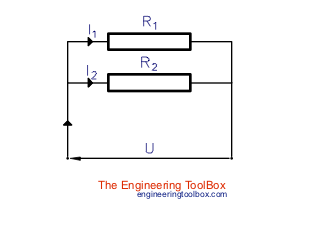Current Divider - Online Calculator
An electric current divider outputs a current that is a fraction of the input current.
A current divider is a linear circuit that produces an output current that is a fraction of the input current.

Current is split between the branches of the divider. The total resistance in the electrical circuit can calculated
RT = R1 R2 / (R1 + R2) (1)
where
RT = total resistance (ohms, Ω)
Rn = resistance in branch n (ohms, Ω)
The voltage difference across the circuit
U = I RT
= I R1 R2 / (R1 + R2) (2)
where
U = electrical potential (volts, V)
I = total current through the circuit (amps, A)
Split current I1 can be calculated
I1 = U / R1
= (I R1 R2 / (R1 + R2)) / R1
= I R2 / (R1 + R2) (3)
Split current I2 can be calculated
I2= U / R2
= (I R1 R2 / (R1 + R2)) / R2
= I R1 / (R1 + R2) (4)
Example - Current Divider
The total resistance in a current divider with supply voltage 3.3 V and resistor R1 = 220 ohm and resistor R2= 47 ohm can be calculated as
RT = (220 ohm) (47 ohm) / ((220 ohm) + (47 ohm))
= 38.7 ohm
The total current through the current divider can be calculated
I = (3.3 V) / (38.7 ohm)
= 0.085 amps
= 85 mA
The current through resistor R1 can be calculated
I1 = (3.3 V) / (220 ohm)
= 0.015 amps
= 15 mA
The current through resistor R2 can be calculated
I2= (3.3 V) / (47 ohm)
= 0.070 amps
= 70 mA
Current Divider - Online Calculator

R - total resistance (ohms)
I1 - split current (amps)
I2- split current (amps)
I - total current (amps)



